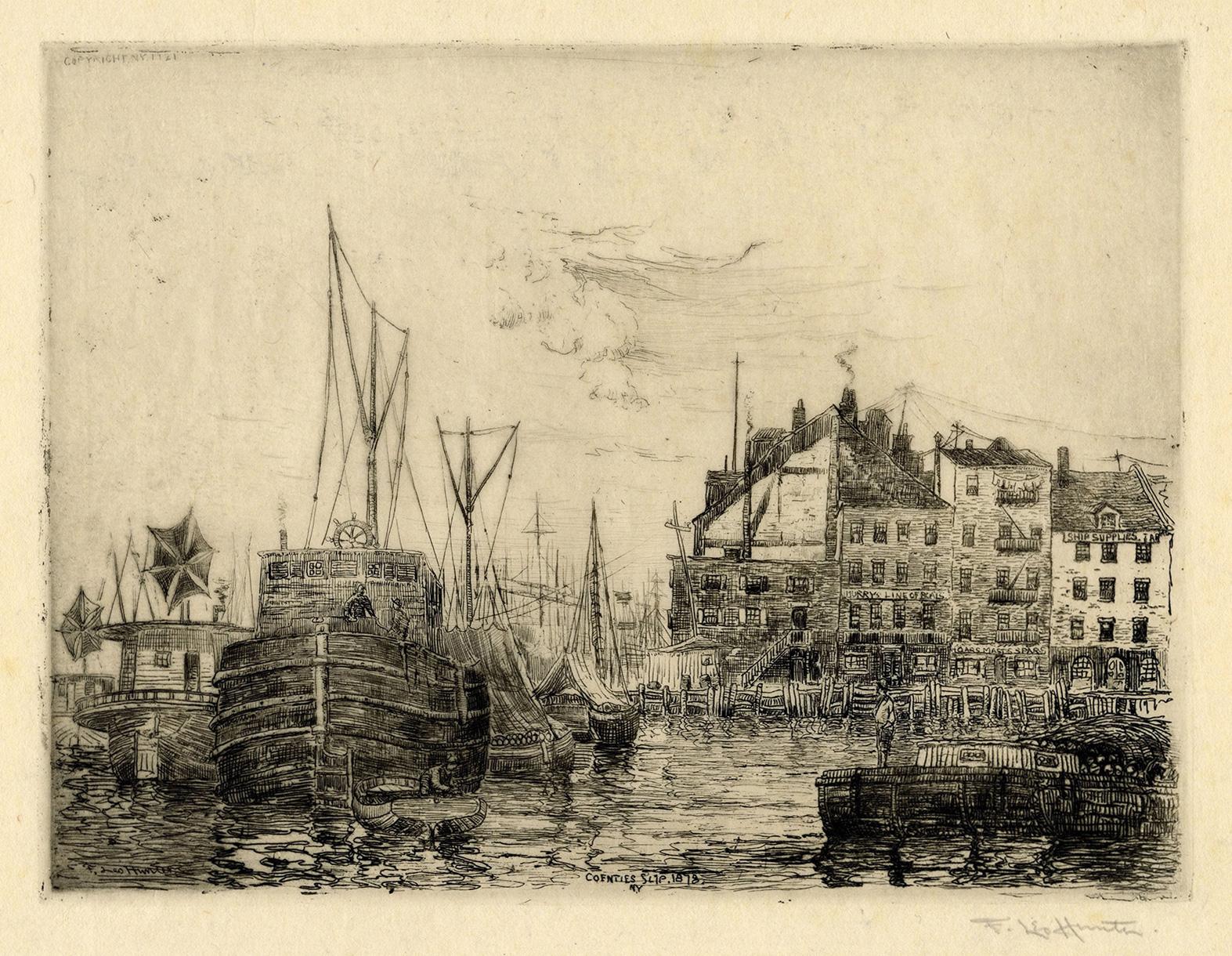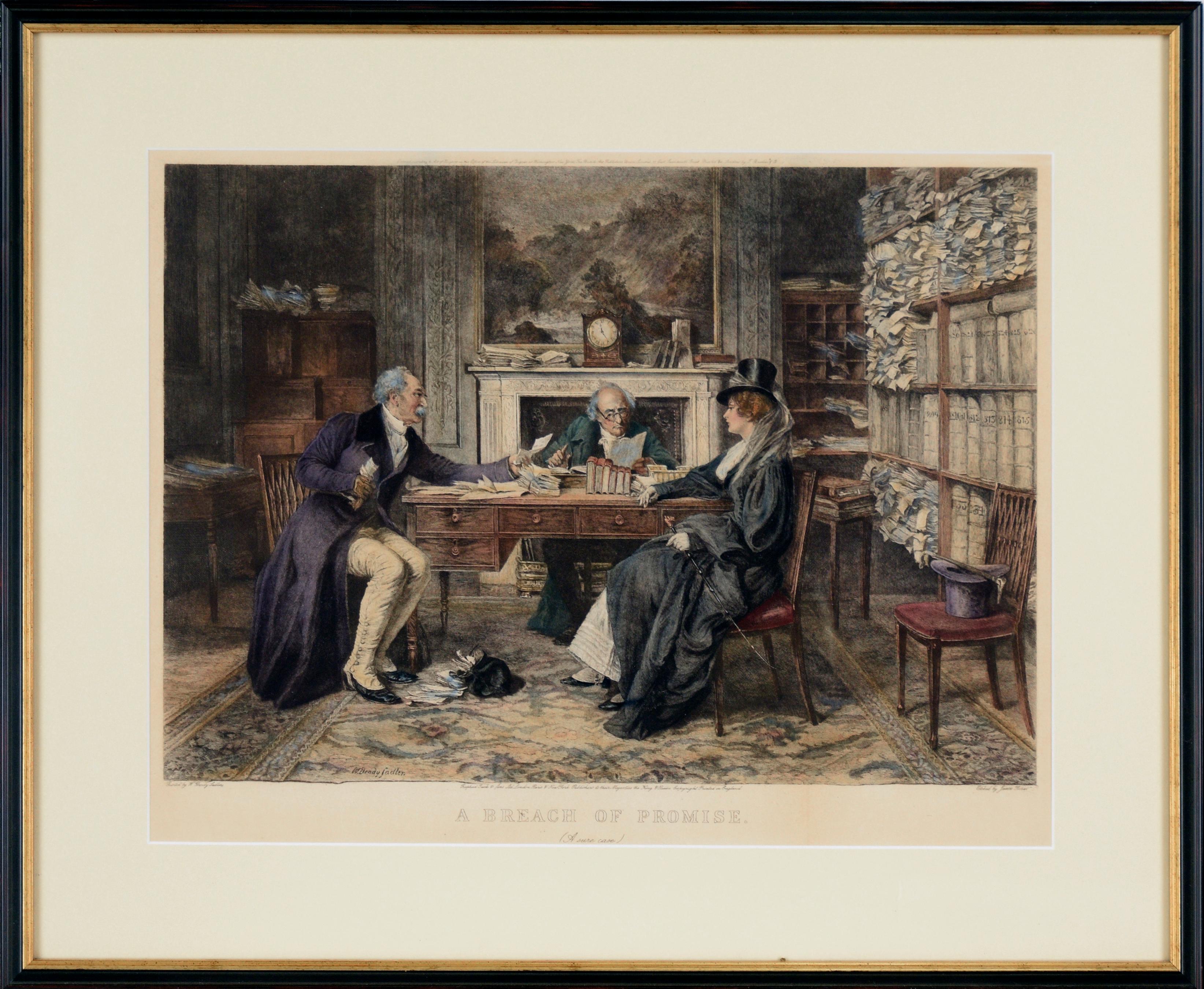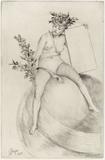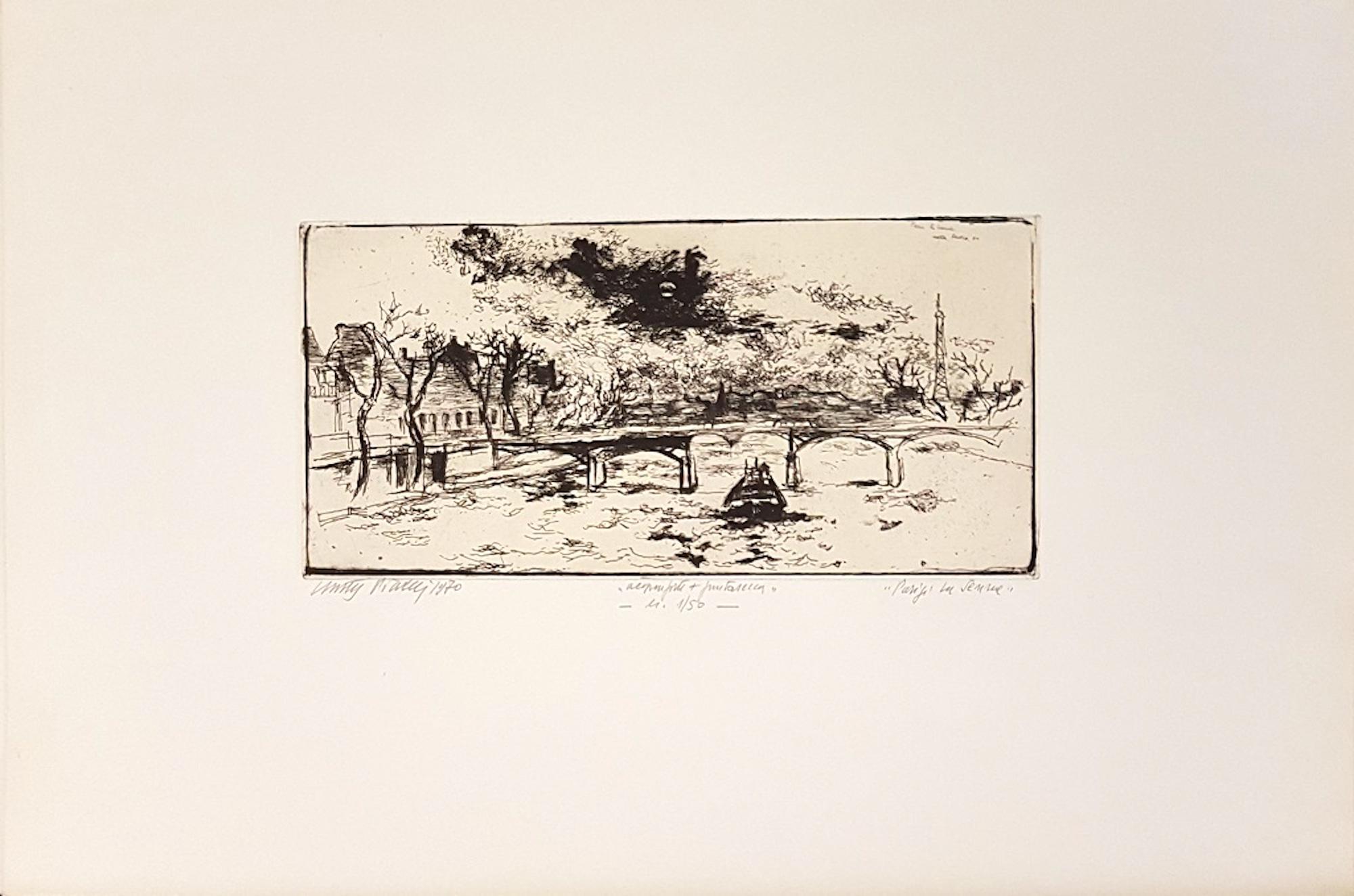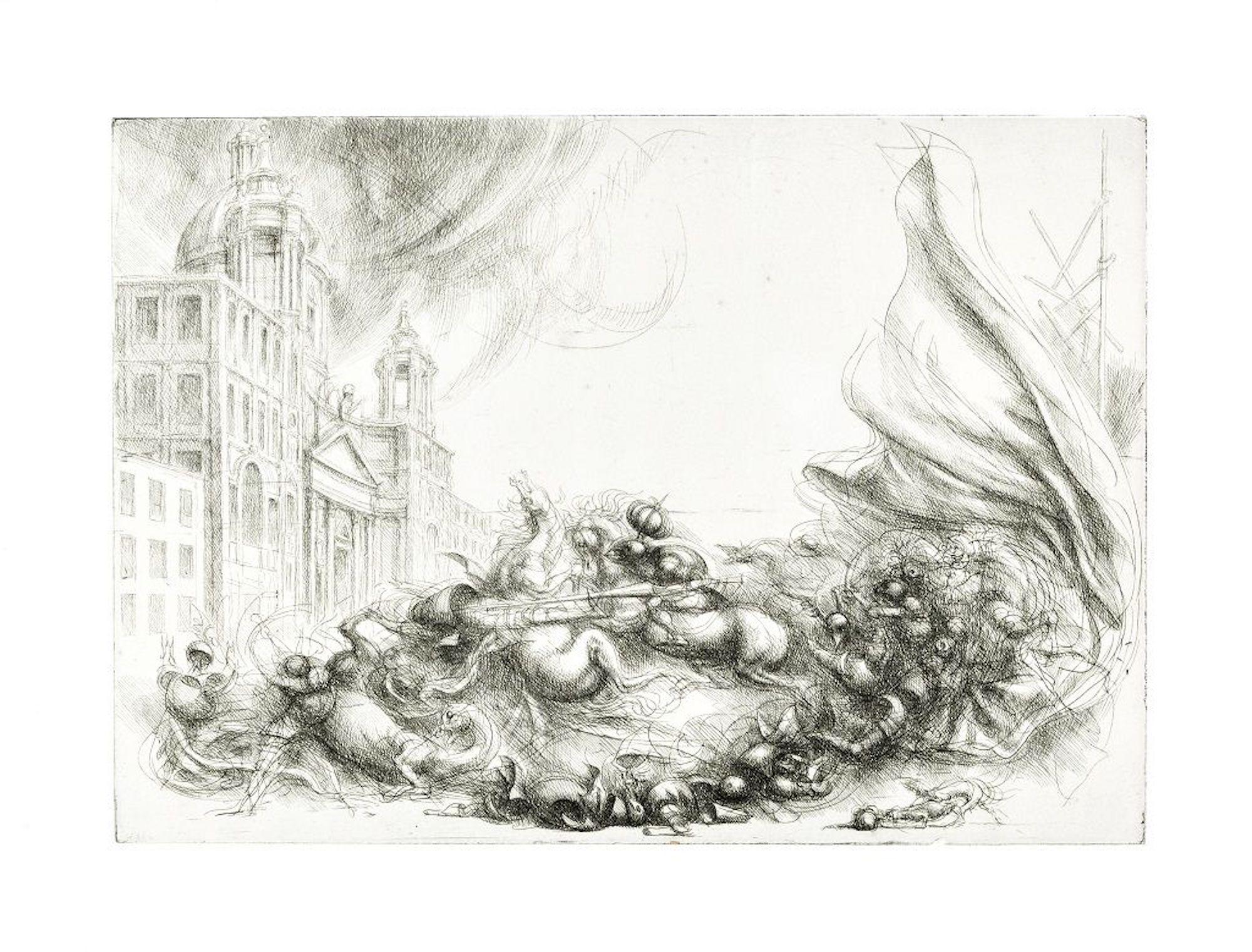Items Similar to La Soeur ainee The Elder Sister
Want more images or videos?
Request additional images or videos from the seller
1 of 5
James Jacques Joseph TissotLa Soeur ainee The Elder Sister1881
1881
About the Item
Based on a photograph of Mrs. Newton with a woman and child, presumably her sister, Mary Hervey and her niece Lilian.
From the 1st edition, printed in London by Goulding
Edition: 100 impressions printed by Goulding, London, 1881
200 impressions printed by Delatre, paris, 1882/3
In the estate vente there were 18 impressions "in different states"
The plate was canceled and in the collection of the Sagot-LeGarrec heirs, Paris
Printed on Dutch, Van Gelder watermark laid paper
Signed and dated in the plate upper center plate edge
Good morning,
Thanks for your email about James Jacque Joseph Tissot works on paper. In addition to the example you wanted more information on, I have the following work by Tissot listed on 1st Dibs. Access them by place the LU_____ number (which is below the title) in the search box. It should take you right to the product page.
Le Matin (Morning)
LU1409989932
La Soeur ainee The Elder Sister
LU1405402222
In Foreign Climes
LU1406944542
Au bord de la mer (At the Sea Side)
LU1409990002
Tissot is a very interesting artist. He was a close friend of both James Whistler and Edgar Degas. You can find a good biographical sketch on Wikipedia. There have been numerous museum exhibitions dedicated to his works in the United States, Europe and Japan.
Please let me know if you have any other questions.
All the best,
Tom French
Thomas French Fine Art LLC
Regarding Soirée d'été (Summer Evening), it is excellent condition. The scholarship is as follows:
Soirée d'été (Summer Evening)
Etching and drypoint, 1881-1882
Signed and dated in the plate lower left corner
Edition: c. 100 in both states; plate canceled
Tissot's lover, Irish divorcee Mrs. Kathleen Newton, resting on a chaise.
Brilliant impression full of rich inking and burr. Bright snappy contrasts.
There is also a painting by Tissot of the same subject. (see photo on 1st Dibs entry)
Condition: Excellent
Image size: 9 5/8 x 16 1/8 inches
Frame size: 18 ¼ x 23 ¾ inches
Reference: Wentworth 56 ii/II
Beraldi 47
Provenance: Christopher Wood Gallery, London (label)
FA7349 $6,750.
James Tissot
Born Jacques Joseph Tissot
15 October 1836, Nantes, July Monarchy
Died 8 August 1902 (aged 65), Chenecey-Buillon, Third French Republic
Occupation painter, illustrator, artist
Jacques Joseph Tissot (French: [tiso]; 15 October 1836 – 8 August 1902), Anglicized as James Tissot (/ˈtɪsoʊ/), was a French painter and illustrator. He was a successful painter of Paris society before moving to London in 1871. He became famous as a genre painter of fashionably dressed women shown in various scenes of everyday life. He also painted scenes and figures from the Bible.
Early life
Jacques Tissot was born in the city of Nantes in France and spent his early childhood there. His father, Marcel Théodore Tissot, was a successful drapery merchant. His mother, Marie Durand, assisted her husband in the family business and designed hats. A devout Catholic, Tissot's mother instilled pious devotion in the future artist from a very young age. Tissot's youth spent in Nantes likely contributed to his frequent depiction of shipping vessels and boats in his later works. The involvement of his parents in the fashion industry is believed to have been an influence on his painting style, as he depicted women's clothing in fine detail. By the time Tissot was 17, he knew he wanted to pursue painting as a career. His father opposed this, preferring his son to follow a business profession, but the young Tissot gained his mother's support for his chosen vocation. Around this time, he began using the given name of James. By 1854 he was commonly known as James Tissot; he may have adopted it because of his increasing interest in everything English.
Early career
In 1856 or 1857, Tissot travelled to Paris to pursue an education in art. While staying with a friend of his mother, painter Jules-Élie Delaunay, Tissot enrolled at the Ecole des Beaux-Arts to study in the studios of Hippolyte Flandrin and Louis Lamothe. Both were successful Lyonnaise painters who moved to Paris to study under Jean-Auguste-Dominique Ingres. Lamothe provided the majority of Tissot's studio education, and the young artist studied on his own by copying works at the Louvre, as did most other artists of the time in their early years. Around this time, Tissot also made the acquaintance of the American James McNeill Whistler, and French painters Edgar Degas (who had also been a student of Lamothe and a friend of Delaunay), and Édouard Manet.
In 1859, Tissot exhibited in the Paris Salon for the first time. He showed five paintings of scenes from the Middle Ages, many depicting scenes from Goethe's Faust. These works show the influence in his work of the Belgian painter Henri Leys (Jan August Hendrik Leys), whom Tissot had met in Antwerp earlier that same year. Other influences include the works of the German painters Peter von Cornelius and Moritz Retzsch. After Tissot had first exhibited at the Salon and before he had been awarded a medal, the French government paid 5,000 francs for his depiction of The Meeting of Faust and Marguerite in 1860, with the painting being exhibited at the Salon the following year, together with a portrait and other paintings.
Mature career
Émile Péreire supplied Tissot's painting Walk in the Snow for the 1862 international exhibition in London; the next year three paintings by Tissot were displayed at the London gallery of Ernest Gambart.
In about 1863, Tissot suddenly shifted his focus from the medieval style to the depiction of modern life through portraits. During this period, Tissot gained high critical acclaim, and quickly became a success as an artist. Like contemporaries such as Alfred Stevens and Claude Monet, Tissot also explored Japonisme, including Japanese objects and costumes in his pictures and expressing style influence. Degas painted a portrait of Tissot from these years (Metropolitan Museum of Art, New York), in which he is sitting below a Japanese screen hanging on the wall.
Tissot fought in the Franco-Prussian War as part of the improvised defence of Paris, joining two companies of the Garde Nationale and later as part of the Paris Commune. His 1870 painting La Partie Carrée (The Foursome) evoked the period of the French revolution. Either because of the radical political associations related to the Paris Commune (which he was believed to have joined mostly to protect his own belongings rather than for shared ideology), or because of better opportunities, he left Paris for London in 1871. During this period, Seymour Haden helped him to learn etching techniques. Having already worked as a caricaturist for Thomas Gibson Bowles, the owner of the magazine Vanity Fair, as well as exhibited at the Royal Academy, Tissot arrived with established social and artistic connections in London. Tissot used the name Coïdé in Vanity Fair from 1869 to 1873.
Tissot quickly developed his reputation as a painter of elegantly dressed women shown in scenes of fashionable life. By 1872 Tissot had bought a house in St John's Wood, an area of London very popular with artists at the time. According to The Oxford Dictionary of Art and Artists, "in 1874 Edmond de Goncourt wrote sarcastically that he had 'a studio with a waiting room where, at all times, there is iced champagne at the disposal of visitors'".
He gained membership of The Arts Club in 1873.
Paintings by Tissot appealed greatly to wealthy British industrialists during the second half of the 19th century. During 1872 he earned 94,515 francs, an income normally only enjoyed by those in the echelons of the upper classes.
In 1874, Degas asked him to join them in the first exhibition organized by the artists who became known as the Impressionists, but Tissot refused. He continued to be close to these artists, however. Berthe Morisot visited him in London in 1874, and he travelled to Venice with Édouard Manet at about the same time. He regularly saw Whistler, who influenced Tissot's Thames river scenes.
In 1875 or 1876, Tissot met Kathleen Newton, a divorcee who became the painter's companion and frequent model. He composed an etching of her in 1876 entitled Portrait of Mrs N., more commonly titled La frileuse. She gave birth to a son, Cecil George Newton in 1876, who is believed to be Tissot's son. She moved into Tissot's household in St. John's Wood in 1876 and lived with him until her death in the late stages of consumption in 1882. Tissot frequently referred to these years with Newton as the happiest of his life, a time when he was able to live out his dream of a family life.
After Kathleen Newton's death, Tissot returned to Paris. A major exhibition of his work took place in 1885 at the Galerie Sedelmeyer, where he showed 15 large paintings in a series called La Femme à Paris. Unlike the genre scenes of fashionable women he painted in London, these paintings represent different types and classes of women, shown in professional and social scenes. The works also show the widespread influence of Japanese prints, as he used unexpected angles and framing from that tradition. He created a monumental context in the size of the canvases. Tissot was among many Western artists and designers influenced at the time by Japanese art, fashion and aesthetics.
Late career
In 1885, Tissot had a revival of his Catholic faith, which led him to spend the rest of his life making paintings about Biblical events. Many of his artist friends were skeptical about his conversion, as it conveniently coincided with the French Catholic revival, a reaction against the secular attitude of the French Third Republic.[citation needed] At a time when French artists were working in Impressionism, Pointillism, and heavy oil washes, Tissot was moving toward realism in his watercolors. To assist in his completion of biblical illustrations, Tissot traveled to the Middle East in 1886, 1889, and 1896 to make studies of the landscape and people. His series of 365 gouache (opaque watercolor) illustrations showing the life of Christ were shown to critical acclaim and enthusiastic audiences in Paris (1894–1895), London (1896) and New York (1898–1899), before being bought by the Brooklyn Museum in 1900. They were published in a French edition in 1896–1897 and in an English one in 1897–1898, bringing Tissot vast wealth and fame. During July 1894, Tissot was awarded the Légion d'honneur, France's most prestigious medal.
Tissot spent the last years of his life working on paintings of subjects from the Old Testament. Although he never completed the series, he exhibited eighty of these paintings in Paris in 1901 and engravings after them were published in 1904
Courtesy Wikipedia
- Creator:James Jacques Joseph Tissot (1836-1902, French)
- Creation Year:1881
- Dimensions:Height: 11.875 in (30.17 cm)Width: 6 in (15.24 cm)
- Medium:
- Movement & Style:
- Period:
- Condition:
- Gallery Location:Fairlawn, OH
- Reference Number:
James Jacques Joseph Tissot
Jacques Joseph Tissot (French: [tiso]; 15 October 1836 – 8 August 1902), Anglicized as James Tissot (), was a French painter and illustrator. He was a successful painter of Paris society before moving to London in 1871. He became famous as a genre painter of fashionably dressed women shown in various scenes of everyday life. He also painted scenes and figures from the Bible.
About the Seller
5.0
Recognized Seller
These prestigious sellers are industry leaders and represent the highest echelon for item quality and design.
Platinum Seller
These expertly vetted sellers are 1stDibs' most experienced sellers and are rated highest by our customers.
Established in 1978
1stDibs seller since 2013
712 sales on 1stDibs
Typical response time: 1 hour
Associations
International Fine Print Dealers Association
- ShippingRetrieving quote...Ships From: Fairlawn, OH
- Return PolicyA return for this item may be initiated within 10 days of delivery.
More From This SellerView All
- Portrait de petite fille, en buste, cheveux sur les epaules (Ellen 14 ans)By Paul César HelleuLocated in Fairlawn, OHPortrait de petite fille, en buste, cheveux sur les epaules (Ellen 14 ans) Portrait of a little girl, bust, hair on shoulders) Drypoint, 1902 Signed lower right corner Very small edition Portrait of the artist's daughter Ellen, at age 14. Title inscribed into the plate upper left Brilliant impression full of burr No stated edition, proofs only, less than 10 imps Unidnetified collector's mark verso: Initials "PH", not in Lugt Reference: Laran, IFF No. 390 Condition: Excellent Image/Plate eize: 14 3/4 x 12 5/8 inches Sheet size: 25 x 16 inches "Paul César Helleu was born in Vannes, Brittany, France. His father, who was a customs inspector, died when Helleu was in his teens. Despite opposition from his mother, he then went to Paris and studied at Lycée Chaptal. In 1876, at age 16, he was admitted to the École des Beaux-Arts, beginning academic training in art with Jean-Léon Gérôme. Helleu attended the Second Impressionist Exhibition in the same year, and made his first acquaintances with John Singer Sargent, James McNeill Whistler, and Claude Monet. He was struck by their modern, bold alla prima technique and outdoor scenes, so far removed from the studio. Following graduation, Helleu took a job with the firm Théodore Deck Ceramique Française hand-painting fine decorative plates. At this same time, he met Giovanni Boldini, a portrait painter with a facile, bravura style, who became a mentor and comrade, and strongly influenced his future artistic style. When he was 18 years old, Helleu established a close friendship with John Singer Sargent, four years his senior, that was to last his lifetime. Already becoming established, Sargent was receiving commissions for his work. Helleu had not sold anything, and was deeply discouraged almost to the point of abandoning his studies. When Sargent heard this, he went to Helleu and picked one of his paintings, praising his technique. Flattered that Sargent would praise his work, he offered to give it to him. Sargent replied, "I shall gladly accept this, Helleu, but not as a gift. I sell my own pictures, and I know what they cost me by the time they are out of my hand. I should never enjoy this pastel if I hadn't paid you a fair and honest price for it." With this he paid him a thousand-franc note. Helleu was commissioned in 1884 to paint a portrait of a young woman named Alice Guérin (1870–1933). They fell in love, and married on 28 July 1886. Throughout their lives together, she was his favourite model. Charming, refined and graceful, she helped introduce them to the aristocratic circles of Paris, where they became popular fixtures. On a trip to London with Jacques-Émile Blanche in 1885, Helleu met Whistler again and visited other prominent artists. His introduction to James Jacques Tissot, an accomplished society painter from France who made his career in England, proved a revelation. In Tissot, Helleu saw, for the first time, the possibilities of drypoint etching with a diamond point stylus directly on a copper plate. Helleu quickly became a virtuoso of the technique, drawing with the same dynamic and sophisticated freedom with his stylus as with his pastels. His prints were very well received, and they had the added advantage that a sitter could have several proofs printed to give to relations or friends. Over the course of his career, Helleu produced more than 2,000 drypoint prints. Soon, Helleu was displaying works to much acclaim at several galleries. Degas encouraged him to submit paintings to the Eighth Impressionist Exhibition in May and June 1886. The show was installed in a Paris apartment at 1 rue Laffitte, which ran concurrently with the official Salon that year to make a statement. Although 17 artists joined the famous exhibit that included the first Neo-Impressionistic works, Helleu, like Monet, refused to participate. Paul Helleu Sketching with His Wife (1889), by John Singer Sargent, The Brooklyn Museum, New York In 1886, Helleu befriended Robert de Montesquiou, the poet and aesthete, who bought six of his drypoints to add to his large print collection. Montesquiou later wrote a book about Helleu that was published in 1913 with reproductions of 100 of his prints and drawings. This volume remains the definitive biography of Helleu. Montesquiou introduced Helleu to Parisian literary salons, where he met Marcel Proust, who also became a friend. Proust created a literary picture of Helleu in his novel Remembrance of Things Past as the painter Elstir. (Later, Helleu engraved a well-known portrait of Proust on his deathbed.) Montesquiou's cousin, the Countess Greffulhe, enabled Helleu to expand his career as a portrait artist to elegant women in the highest ranks of Paris society, portraits that provide the basis for his modern reputation. His subjects included the Duchess of Marlborough, the Marchesa Casati, Belle da Costa Greene, Louise Chéruit, and Helena Rubinstein. Looking for new inspiration, Helleu began a series of paintings and color prints of cathedrals and stained glass windows in 1893, followed by flower studies and landscapes of parks in Versailles. Helleu took up sailing, owning four yachts over his life. Ships, harbor views, life at port in Deauville, and women in their fashionable seaside attire became subjects for many vivid and spirited works. In 1904, Helleu was awarded the Légion d'honneur and became one of the most celebrated artists of the Edwardian era in both Paris and London. He was an honorary member in important beaux-arts societies, including the International Society of Painters, Sculptors, and Engravers, headed by Auguste Rodin, and the Société Nationale des Beaux-Arts. On his second trip to the United States in 1912, Helleu was awarded the commission to design was the ceiling decoration in New York City's Grand Central Terminal. He decided on a mural of a blue-green night...Category
Early 1900s Art Nouveau Figurative Prints
MaterialsDrypoint
- La ToiletteBy Louis LegrandLocated in Fairlawn, OHLa Toilette Drypoint, 1908 Signed and numbered in pencil by the artist (see photos) Edition: 65 this state (35/65) Published by Gustave Pellet (1859-1919),...Category
Early 1900s Art Nouveau Figurative Prints
MaterialsDrypoint
- On Christmas DayBy Gene KlossLocated in Fairlawn, OHOn Christmas Day Drypoint and aquatint, 1979 Signed lower right: Gene Kloss (see photo) Inscribed lower left: "Artist's Proof", and titled "On Christmas Day" An "artist's proof" imp...Category
1970s American Modern Figurative Prints
MaterialsDrypoint
- Keresan DancersBy Gene KlossLocated in Fairlawn, OHKeresan Dancers Etching & drypoint, 1962 Signed lower right (see photo) Inscribed lower left: "Artist's Proof Keresan Dancers" Depicts Keresan speaking peoples at Sam Felipe Pue...Category
1960s American Realist Figurative Prints
MaterialsDrypoint
- Woman's Head (Vrouwekop), Marguerite Adolphine HelfrichBy Jan TooropLocated in Fairlawn, OHWoman's Head (Vrouwekop), Marguerite Adolphine Helfrich Drypoint, 1897 Signed lower right in pencil: J Toorop; by later hand Toorop's model for this print was Marguerite Adolphine H...Category
1890s Jugendstil Figurative Prints
MaterialsDrypoint
- Bare Arms (The Practice #2)By Darius StewardLocated in Fairlawn, OHBare Arms (The Practice #2) Drypoint on Aluminum, 2019 Signed with initials lower right Edition: 8 impressions (all uncolored), this “6 out of 8” There are also 4 AP, 2 with hand coloring Printed on Twinrocker all purpose paper Published by Thomas French Fine Art...Category
2010s Contemporary Figurative Prints
MaterialsDrypoint
You May Also Like
- Coentes Slip, NYBy Frederick Leo HunterLocated in Middletown, NYEtching with drypoint on hand made laid Japan paper with a deckle edge, 8 9/16 x 11 5/8 inches (220 x 296 mm), full margins. Signed, dated and titled in pencil in the margin, recto. ...Category
Late 19th Century Victorian Landscape Prints
MaterialsHandmade Paper, Laid Paper, Drypoint, Etching
- A Breach of Promise - Hand Colored Etching on Paper 1900 VictorianBy James DobieLocated in Soquel, CAVictorian-style drypoint etching by James Dobie (British, 1849-1911), after a painting by Walter Dendy Sadler. Printed in London by J. Brooker & Co. and ha...Category
Early 20th Century Victorian Figurative Prints
MaterialsPaper, Watercolor, Drypoint, Etching
- Second Frontispiece (Sitting on the Globe)By James Jacques Joseph TissotLocated in San Francisco, CAOriginal drypoint printed in black ink on laid paper bearing a portion of the Van Gelder watermark (fleur-de-lys in a crowned shield surmounting the letters “VGZ”). Signed and dat...Category
19th Century Victorian Figurative Prints
MaterialsDrypoint
- La Mode de Paris, French late 19th century colour fashion illustration engravingLocated in Melbourne, Victoria'La Mode de Paris' Wood-engraving with original hand-colouring. French 1870s fashion illustration, from a series called 'La Mode de Paris'. Signed in ...Category
Late 19th Century Victorian Figurative Prints
MaterialsEngraving
- La Mode de Paris, French late 19th century colour fashion illustration engravingLocated in Melbourne, Victoria'La Mode de Paris' Wood-engraving with original hand-colouring. French 1870s fashion illustration, from a series called 'La Mode de Paris'. Signed in ...Category
Late 19th Century Victorian Figurative Prints
MaterialsEngraving
- La Mode de Paris, French late 19th century colour fashion illustration engravingLocated in Melbourne, Victoria'La Mode de Paris' Wood-engraving with original hand-colouring. French 1870s fashion illustration, from a series called 'La Mode de Paris'. Signed in ...Category
Late 19th Century Victorian Figurative Prints
MaterialsEngraving
